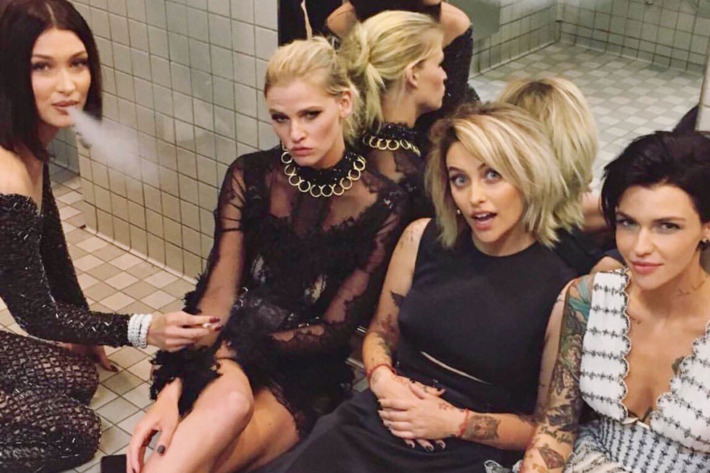A post shared by Frances Bean Cobain (@space_witch666) on May 8, 2017 at 12:14am PDT
This article was originally published by i-D Australia.
Since the 80s, smoking has been on a steady decline. In 2013, a National Drug Strategy Household Survey report found that the rate of adults who light up has halved in the passing decades. Today, roughly 11.9% of adults smoke — down from a staggering 42% in the 60s. The numbers are even lower among young people: in 2014, it was reported that only 5.1% of students aged between 12 and 17 indulged in smoking. The shift is understandable considering the aggressive public health messaging and increasing restrictions. If you can stomach a fag after being exposed to the photos of rotten lungs that clog modern anti-smoking campaigns, you’d still struggle to find anywhere you’re allowed to smoke it.
But you don’t have to have a nose for statistics to observe that our interest in cigarettes is waning; the trend is widely reflected in popular culture. In the middle of the last century, smoking on screen was ubiquitous. Later a short hand to show a character was cool or rebellious or sophisticated. Now, it’s more likely to mark a villain, signify death and decay, or warn of an upcoming emotional crisis. From Love to Mad Men, chain smoking is a habit of the nervous and unhappy or those living through the 50s-60s in period pieces.
For a while, it seemed like fashion was following suit. The image of rail-thin models existing on cigs and black coffee appeared to recede at the end of the 90s. In the early 00s Christy Turlington, previously a long chain smoker, became the face of fashion’s move to quit. After losing her dad to lung cancer and being diagnosed with early-stage emphysema in her 30s, she appeared in a series of commercials urging people to give up cigarettes.
It was the beginning of an image shift that echoed throughout the industry at the start of the millennium. The excess of the 80s and heroin chic of the 90s faded as the idea of the model lifestyle became less rock and roll and more mother earth. Superstars like Miranda Kerr and Gisele championed organic food, early nights, active lifestyles, and meditation. Tabloid features showed models emerging from gyms in the early hours of the morning, not clubs.
That was until 2011, when the coolest bad girl of them all, Kate Moss, appeared on the Louis Vuitton runway with a lit cigarette in hand. She was not only dismissing the growing social convention, but also the venue’s anti-smoking policy. Marc Jacobs reportedly happily paid the fine to see his muse make such a talked about return. But her appearance wasn’t only a professional statement but a social one: the bad girl model was back.
The connection between smoking and female rebellion are well documented. A century ago, to light up in public as a woman was a defiant act that flouted social, class, and gender conventions. In 1901, a The New York Times article claimed women smoking was “growing to be a menace in this country.” Lighting up showed you weren’t interested in following someone else’s rules — and was a message the cigarette industry clung to immediately.
By the 1920s, early PR guru Edward Bernays leveraged the suffragette movement and encouraged women to smoke during a 1929 Easter Day parade as a demonstration of their liberation. The Times ran a headline the next day reading, “Group of Girls Puff at Cigarettes as a Gesture of ‘Freedom’.” It was a manipulative move that stuck.
Reviewing recent glossy editorials featuring stars like Bella and Gigi Hadid and Kendall Jenner clutching cigarettes, it’s clear the messaging has survived across the century. A dangling cigarette still exists as a signifier to danger and delight in a way that has been increasingly abandoned elsewhere. Fashion’s love of cigarettes is a lingering example of advertisers manipulating women’s self image to sell them something they don’t really want. It’s an ironic throwback during a time when identity politics and gender discussions are as common in these publications as clothing credits.
Nowhere was this all more visible than in the conversation surrounding the piles of smoking bathroom selfies that were posted after the Met Gala. Beautiful famous young things posed, cigarette in hand, like any other rebels in a high school bathroom. The only thing was, people didn’t appear to buy it this time. Twitter and Instagram lit up with young people — not disgruntled parents — asking what they were doing? It was a real world demonstration of how far the fashion aesthetic has drifted from the public consciousness.
Smoking was once the accessory of the rebel, a way to tell the world you didn’t give a shit about what they think. But today, teenagers and young adults roll their eyes at such obvious posturing. They have a very different standard of rebellion. They don’t need to be sold a picture of defiance — they’re thinking and speaking for themselves, not using visual crutches to demonstrate that they’re their own person.
Credits
Text Wendy Syfret
Image via Twitter
